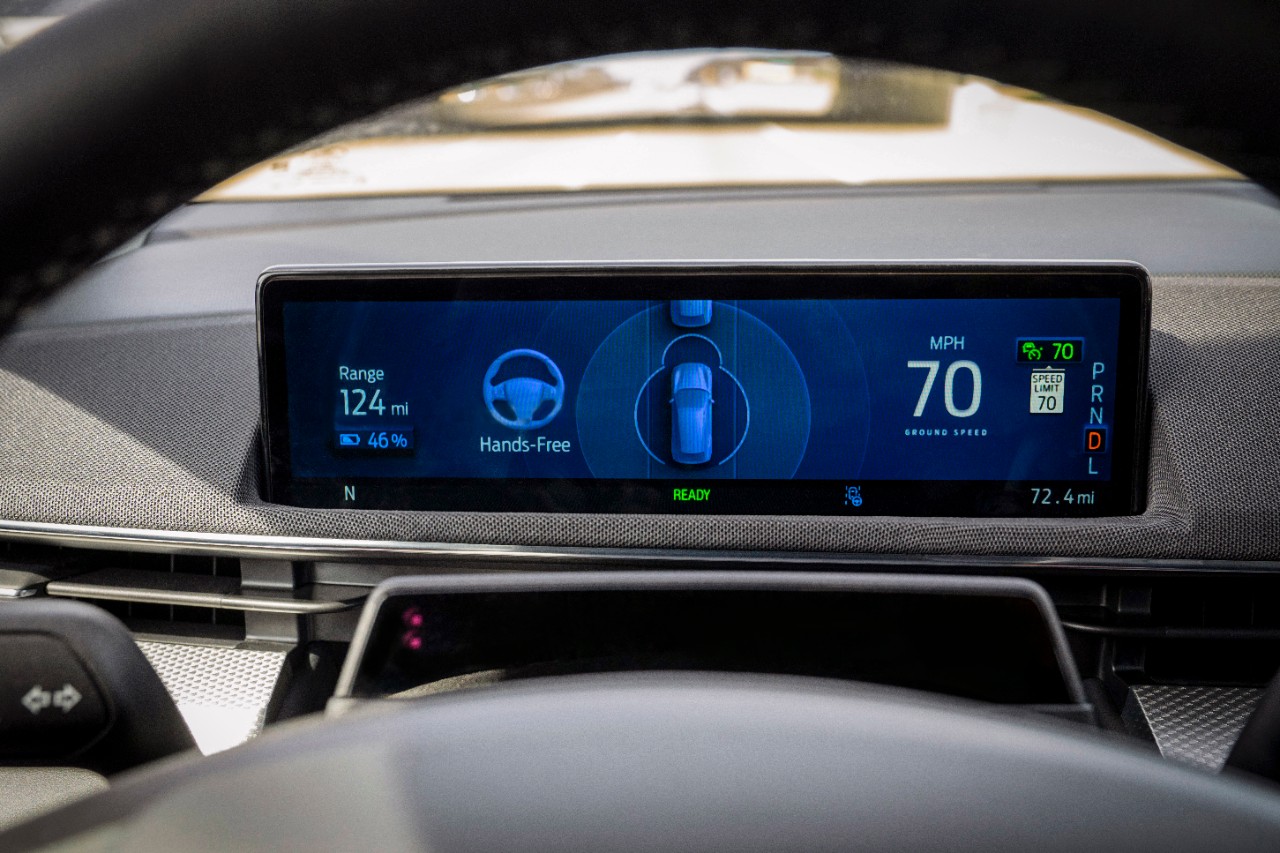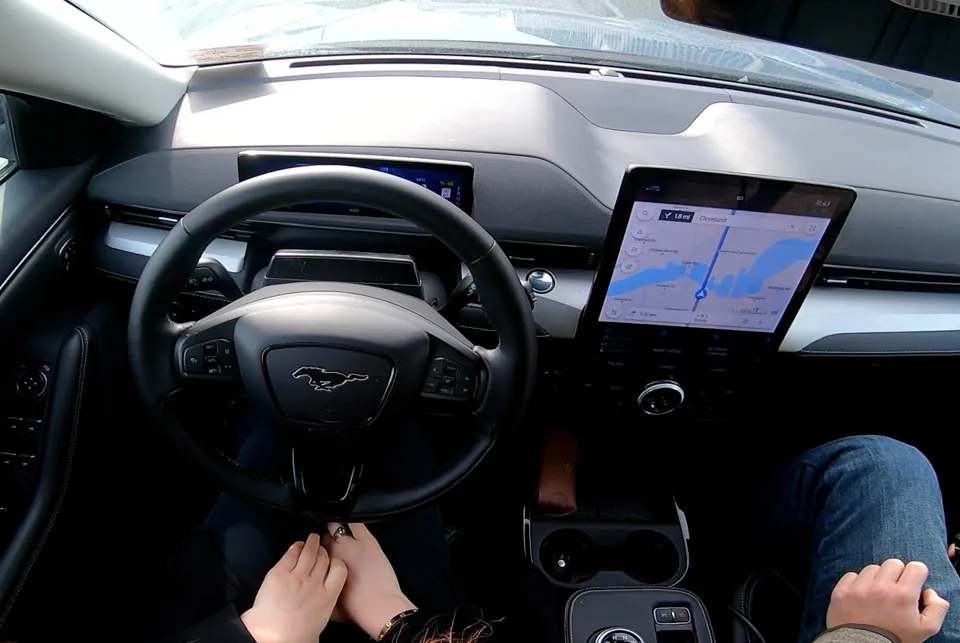The benefit of Ford’s hands-off driver assistance system has been questioned by fleets, who fear the technology could also pose a risk to road safety.
Ford revealed the UK’s first hands-off driver assistance system that can be used on motorways last month (April 2023).
Called BlueCruise, it is making its debut on the Ford Mustang Mach-E and has been approved for use on UK roads by the Department for Transport (DfT).
Paul Hollick, chair of the Association of Fleet Professionals (AFP), said: “Any form of technology which means a driver, through ignorance more than anything, thinks that they don’t need to do something is scary for us as fleet operators.
“I can just see drivers that have got that system watching a Netflix movie or trying to read a book while they’re driving home, without being sensible and proactive on the roads.
“From a fleet management perspective, I think it’s just scary. Drivers still need to drive, and drivers still need to be the centre of everything.”
Appearing alongside Hollick on April’s Fleet News at 10 webinar, Duncan Webb, fleet director at the AA, said he was “really nervous” about the technology.
“Just knowing you don’t have to be as in control of the car worries me that the role of the driver is becoming even more dumbed down... and might end up presenting a greater risk,” he added.
BlueCruise enables hands-free assisted driving at speeds of up to 80mph by monitoring road markings, speed signs and evolving traffic conditions to control steering, acceleration, braking and lane positioning.
It is classified as a Level 2 autonomous system and can be activated on 2,300 miles of pre-mapped motorways in England, Scotland and Wales, designated as Blue Zones.
Drivers must remain attentive at all times and are monitored by an infrared camera continually.
“I wouldn’t be recommending to my business that we pay a monthly subscription for something like this,” Chris Connors, Vistry Group
If the system detects driver inattention, warning messages are first displayed in the instrument cluster, followed by audible alerts, brake activations, and finally slowing of the vehicle while maintaining steering control.
Similar actions are performed if the driver fails to place their hands back on the steering wheel when prompted when leaving a Blue Zone.
Where is the benefit?
Chris Connors, head of facilities and fleet at the Vistry Group, told Fleet News at 10: “I think there are a lot of (automated safety) systems that have really benefited the driver and really helped us.
“The principle of technology improving safety is good. I’ve always thought that the weakest link in a vehicle is generally the person behind the wheel rather than the vehicle itself.”
However, he said: "If I've got to concentrate on the road in front of me, what’s the point of me just being able to take my hands off the wheel?”
“I can’t see the benefit to me as a driver and so to the fleet.
“Would I allow one of our drivers to utilise it? I would want to certainly see more information, perhaps some training and education about the system, but in principle, if a driver wanted it, I would support them.”
However, noting the £17.99 monthly subscription for the BlueCruise system, he added: “I wouldn’t be recommending to my business that we pay a monthly subscription for something like this.”
Fleet News at 10 features a guest panel of leading fleet decision-makers discussing the month’s biggest news and hottest industry topics.
The next webinar take place on Friday (May 26) from 10-11am, register by clicking here.
You can view all of the Fleet News at 10 webinars on demand by clicking here.
A safe system
Ford says its engineers undertook 100,000 miles of testing on European roads to validate latest-generation advanced driver assistance systems, including BlueCruise and its supporting features.
More than 600,000 miles covered in the US and Canada before the system was introduced to those markets last year.
Validation drives in Great Britain, says the manufacturer, have helped prove the system’s ability to handle circumstances drivers encounter every day, such as worn-out lane markings, poor weather and roadworks.
Torsten Wey, manager for advanced driver assistance systems at Ford Europe, said: “There’s a good reason why Ford BlueCruise is the first hands-free driving system to be cleared for use in a European country.
“We’ve proven beyond doubt that it can support the driver while also ensuring that they keep their eyes on the road for their safety and that of their passengers while the system is active.”

Peter Golding, managing director at FleetCheck, says that the fleet industry has been discussing the theoretical implications of hands-free driving for some time. But he added: “The real-world availability of BlueCruise has brought everything into immediate and sharp relief.”
The obvious question, according to Golding, is do fleets feel that it is safe for their drivers to be using the technology?
He said: “Obviously, it has been officially signed off and Ford say that millions of miles have been safely covered. But do employers feel those assurances are sufficient for what remains quite a fundamental shift in driving practice?”
Would you be happy for your drivers to use a hands-off driver assistance system, such as Ford's BlueCruise? Answer our poll question.
“Certainly, allowing its use on your fleet would mean that it needed to be incorporated into your risk management policy and that drivers understand how and when it can be used,” added Golding.
“This is a legitimate criticism that is sometimes levelled at less sophisticated advanced driver assistance systems, that drivers are not given sufficient information about how to integrate devices into their day-to-day driving while also recognising their limitations.
“With BlueCruise, there appears to be a high level of safeguarding built in, with the driver being monitored to ensure they are paying attention to the road, but fleets providing vehicles still need to ensure they have a high degree of understanding when using the technology.”
Drivers ‘ready’ for more autonomy
May’s Startline Used Car Tracker reports that more than two-thirds of motorists (67%) are ready to start using self-driving cars.
Furthermore, 43% of respondents to its latest survey say that autonomous technology would make journeys more relaxing.
However, just one-in-four (27%) say it would make motoring safer, while only 17% believe it would be reliable.
Almost a quarter (23%) of respondents to Startline’s survey said they would not trust autonomous technology, 16% are more confident in their own driving, 11% believe it is likely to be expensive and 8% that it would be complex and probably break down frequently.
As of January 2023, car manufacturers have been able to seek type approval to launch Level 3 technologies with expanded self-driving capabilities at speed of up to 80mph.
The rules previously capped the use of such systems to 37mph but were not adopted by the UK Government. Ministers gave the green-light to allow self-driving cars last August.
Ford is one of the latest manufacturers to confirm their attendance at this year’s Company Car in Action show.
The UK’s premier fleet driving event, which takes place at Millbrook Proving Ground in Bedfordshire on June 14-15, now has 17 manufacturer brands signed up, with more expected to confirm in the coming weeks.
Ford, the current Fleet News Awards van manufacturer of the year, will be bringing a variety of models from its expansive range, from fun-to-drive, fuel-efficient cars to versatile, capable utility vehicles and tough, durable commercial vehicles.
To sign up for the Company Car in Action show, click here.
























Login to comment
Comments
No comments have been made yet.